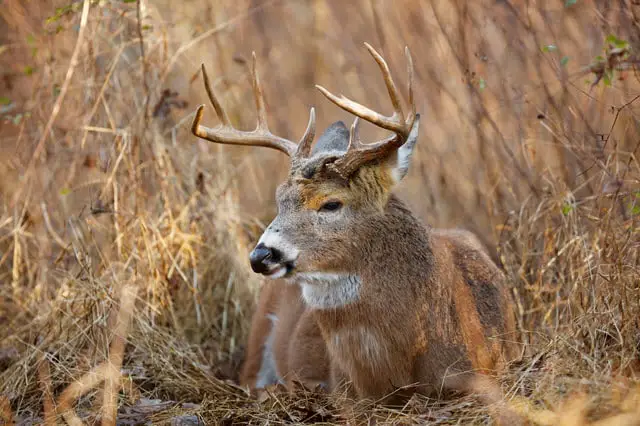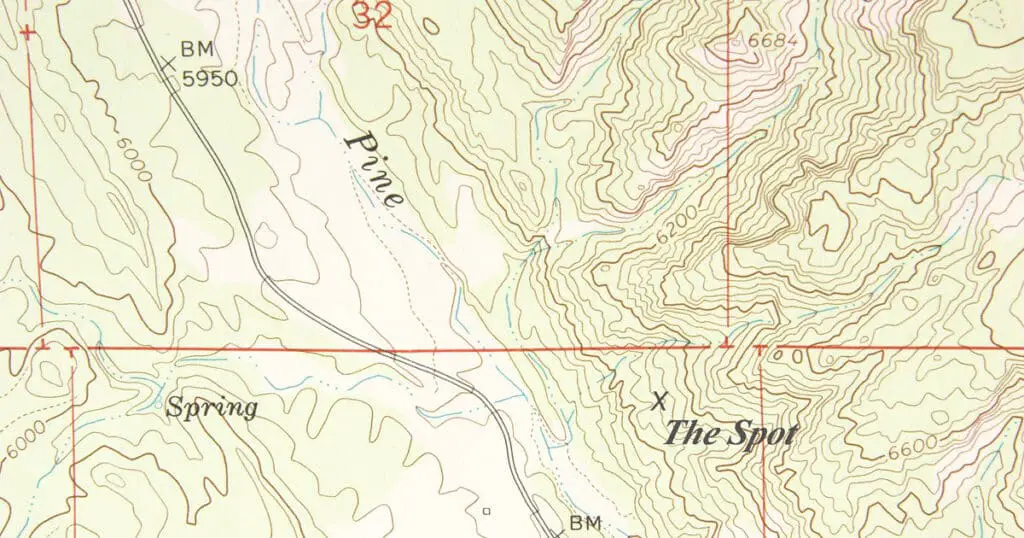Efficiently finding deer is one of the most important parts of hunting. There are many things to consider when searching for deer, and the best way to try and find deer is to think like a deer. Deer are instinctual animals, but they are smart. One of the easiest ways to locate deer is to find their bedding areas. Bedding areas are, unsurprisingly, where deer will hunker down to sleep. But you’re probably wondering how to find deer bedding areas on a map, or when scouting an area in the woods.
Since deer are active throughout the day and at night, a single deer could have multiple bedding areas.
There are several tricks to finding deer bedding areas, and in this article we’ve outlined some of the most important things to think about when looking for deer bedding sites.
How Do You Find Deer Bedding Areas on a Map?
Before you head out hunting, you should be familiar with the area. If you’re hunting deer on land where you’ve never hunted on before, looking at a map can give you vital information about where to find deer. There are two types of maps to look at, topographical and satellite.

Topographical maps can be hard to interpret the first few times you look at one, but after a little while they start to make sense.
If the area where you’re hunting is entirely flat, a topographical map probably won’t be too useful, but there could be more hills and slopes than you think.
The smallest circles in a topographical map represent the highest points. Deer tend to bed on slopes or, ideally, between slopes.
Slopes offer protection from the wind, and they give deer a good escape route if they need to run downhill quickly.
Satellite maps are helpful because they can give you an image of the forest coverage and the resources deer need. Deer need food and water, so if you can identify a good source of water, such as a river or lake, it’s probably an ideal deer bedding ground.
Though it might seem like forests would be an ideal place for deer to set up their bedding areas, deer normally don’t bed in forests except on public lands where hunters are a bigger threat. Deer prefer to bed in areas with high grass coverage or on the edge of forests.
Hunting With Maps on Private vs Public Land
If you’re hunting on public land, there are probably a lot more available resources when it comes to maps. But if you have access to this information, so does every other hunter. That’s why most hunters prefer hunting on private land.
Maps can be helpful on private land since the deer tracking and hunting strategies remain the same. The only difference is that on private land there will be less competition, and the deer are more less likely to know that you’re coming.
How Far Do Bucks Bed from Food?
Bucks tend to bed fairly close to good food and water sources. If there is an area that offers better protection but has less food, the buck will probably choose the area with better shelter.

A buck’s diet changes throughout the year, so his food sources will change depending on the season.
Deer’s bodies are designed to stock up on food in summer and fall so that they can survive the winter when there is less food naturally available.
When there are berries and fruits available, they will probably be bedding closer to bushes.
Deer Bedding and Wind
Deer like to sleep with the wind hitting their back. Since the direction of the wind will probably change several times throughout the night, deer will get up and change positions frequently.
This makes the bedding area slightly bigger than the size of a deer.
If there is a slope, it can also give you a hint about which direction the deer is going to be facing and where its going to set up its bedding area. Deer tend to prefer southwest facing slopes since it tends to give them the most sunshine.
Do Deer Bed Down at the Same Place Every Night?
Deer are about as diverse as humans when it comes to bedding, and there are many different types of deer.
Certain species are more social than others, and during the rutting and mating season a deer’s behavior is different than during the rest of the year.
When they can, deer tend to bed down at the same place every night. This shouldn’t be taken as a given, and if a deer senses that its bedding area has been visited by a potential predator, it will select a new bedding area without hesitation.
Deer also have day bedding areas. Unlike humans, deer don’t sleep through the night. Instead, they are active throughout the day and sleep sporadically for small intervals of time.
This means that a deer could have multiple favorite bedding spots, some for nighttime and others for the day.
Deer Bedding Signs
Next time you’re scouting the area, think about the things we already mentioned like slope and natural resources when looking for a bedding area.

Once you’ve narrowed it down, you can look for other signs of deer activity like plants that have been partially chewed or deer tracks, and deer droppings.
A deer bed is identifiable as an oval depression in the ground that is slightly larger than the size of a deer. This can take some time to spot, but once you’ve seen one, you’ll be able to recognize them in no time.
Once you’ve found a bed, look around to see if there is only one bed or if there is a cluster of beds in the area. If there is only one bed, it’s safe to assume that the bed probably belongs to a buck on its own.
If there is one bed with smaller ones around it, the bed most likely is a home for a doe and her fawns.
Some deer live in families, and if this is the case there will often be one buck bed with several doe beds scattered around it. They don’t like to sleep huddled together, so there will be a few feet between the beds of all of the deer in the group (or herd).
Locating Whitetail Bedding Areas
Whitetail deer are the most common deer in North America. They are also the most hunted, so it’s important to know a bit about them, though there is nothing particularly unique about whitetail bedding in itself.
Everything we’ve said about deer applies to whitetail deer, but since whitetail deer live all over the country, there is a huge variety to how whitetail deer like to bed. The basics of deer bedding still apply.

Whitetail deer look for shelter and protection from the wind, and they bed close to potential resources.
Depending on where you are and what time of year it is, this could look very different. That’s why it is extremely important to be familiar with the area where you’re hunting and to plan before you head out.
Since whitetail deer are some of the most commonly hunted, it’s also easy to find information on where they might be bedding.
If you’re hunting on public land, you can often find information about the land featuring information provided by hunters.
Locating Mule Deer Bedding Areas
Mule deer are less common than whitetail deer, but they are still fairly popular to hunt. The two species are fairly similar, but they inhabit different areas of North America.
While whitetail deer live mostly East of the Rocky Mountains and have a much wider range, mule deer can be found West of the Rocky Mountains and in the Great Plains.
Even though mule deer inhabit a smaller area, their terrain covers several different types of climates.
Mule deer living in the mountains are going to have a better opportunity to find hiding spaces in slopes and rocky areas, whereas deer living on the plains aren’t going to have as much natural protection from the landscape.

Compared to whitetail deer, mule deer seem to prefer bedding close to their food sources, so this can be good to keep in mind if you’re on the hunt for mule deer.
Once again, finding deer bedding comes down to knowing the land and being extremely well prepared. If you keep in mind the things we’ve talked about, you shouldn’t have trouble finding mule deer bedding.
How to Find Deer Bedding Areas (final thoughts)
Finding deer bedding is essential to a successful hunting season. It can be overwhelming to remember all these things at first, but once you’ve done it a few times, you’ll find yourself finding deer bedding without even looking.
Successfully locating deer bedding comes down to two main factors: preparation, and thinking like a deer.
Using maps and listening to stories from other hunters can help you be prepared. This is especially true if you are unfamiliar with the area.
Keeping in mind all the things a deer might need will help you think more like a deer and, if you really want to test it out, next time you find a deer bedding, crouch down and look around and really look through a deer’s eyes.


